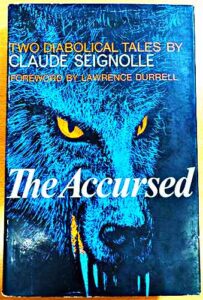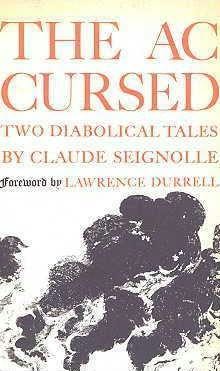By CLAUDE SEIGNOLLE (Coward-McCann; 1963/67)
This, the first-ever English translation of the work of France’s Claude Seignolle, is required reading for all true horror fans. Why? Because Seignolle is one of the world’s greatest and most idiosyncratic masters of dark fantasy, and the two novellas collected in THE ACCURSED, ably translated by Bernard Wall, are both quite representative of Seignolle’s peculiar universe.
As with much of Seignolle’s fiction, “Malvenue” and “Marie the Wolf” were directly inspired by European folklore, and distinguished by rich and atmospheric depictions of life in the French countryside, where the supernatural is a real and dangerous entity. Seignolle’s prose is highly poetic and often surreal in nature, yet his tales still satisfy as intense and well-structured horrific yarns.
“Malvenue,” the first and longest of THE ACCURSED’S contents, concerns the sixteen year old Jeanne, a.k.a. Malvenue, who upon unearthing the head of an ancient stone becomes possessed with an overpowering desire to commit evil acts. A lengthy flashback relates how the head was previously unearthed decades earlier by the farmer Moarc’h, and how it brought all manner of misfortune to Moarc’h and his wife Henriette—who, it transpires, is Jeanne’s mother. Jeanne, moreover, was conceived the very night Moarc’h initially unearthed the stone head. Clearly Jeanne has some kind of unholy connection with the object, and also perhaps with a spectral washerwoman with no head who appears in the swamps one day…
THE ACCURSED’S second tale “Marie the Wolf” again concerns a naïve farm girl beset by a horrific curse. Eighteen year old Marie has an ominous wolf-like manner, bequeathed by a wolf-herder who visited her home when Marie was a little girl and placed her hand in a wolf cub’s mouth. This, the man claimed, gave Marie the power to communicate with wolves and cure their bites, but only until the man dies, at which point Marie’s powers will cease. This may or may not mean that Marie is the werewolf that appears to be loose in her village, although it’s the ignorance of Marie’s fellow villagers that proves to be the real evil.
There’s far more to these tales than the above summaries indicate, as both are triumphs of invention and erudition in addition to their qualities as plays on age-old folklore. Claude Seignolle is nothing if not multi-faceted, and these two stories are first-rate introductions to his consistently unpredictable genius.


